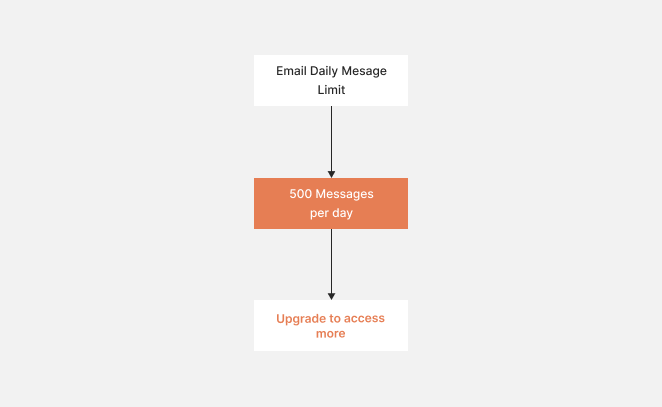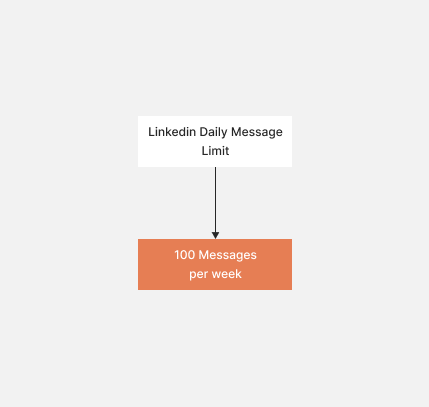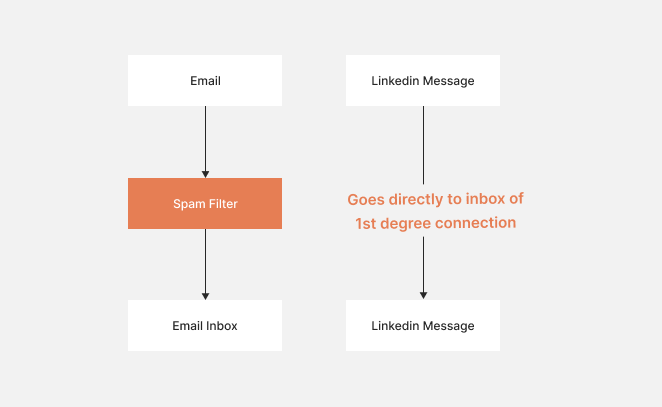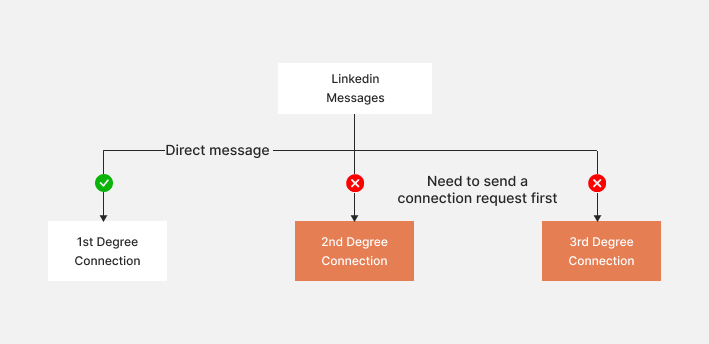Email vs Linkedin Message: Best Outreach Strategy
The comparison between the performance of LinkedIn messages or Emails!

In our digitally advanced world, each day welcomes a new or improved method of doing things. Techniques are changing so fast, it is hard to keep up with them. A few years ago, you wouldn't be reading an article about email vs LinkedIn message.
Before now, email was the giant as far as B2B communication was concerned. No other medium came close to customer engagement and lead generation. But as you probably already know (otherwise you won't be reading this article), things have changed. There is a new player in the game—LinkedIn.
In this article, we will, first of all, be reminded of what email and LinkedIn messages are. Then, we will thoroughly analyze their differences and similarities. And to wrap it up, we will answer the question: Email vs LinkedIn message, which one is a better B2B outreach strategy in 2022?
Email, also known as Electronic Mail, is a medium of communication every B2B professional is familiar with. For years, it reigned as the most popular and effective means to communicate with prospects. Examples of email providers include Gmail, Outlook, Yahoo! mail, etc.
LinkedIn message
The LinkedIn message, on the other hand, is a direct messaging feature on LinkedIn that you can use to communicate with other users on the platform who are your 1st-degree connection.
Now that you are reminded of both communication mediums, let's proceed to explore the main point of this article: Email vs LinkedIn message.
Email vs LinkedIn message: Comparison
On one hand are some professionals who hold that email still rules B2B communication in 2022. On the other hand, other professionals believe that the LinkedIn message is the new giant in the game of prospecting and lead generation. All that said, which one is better?
Clearly, email vs LinkedIn messages have their respective advantages and disadvantages. We will compare them in the following paragraphs using these 8 criteria:
- Open rate
- Reply rate
- Follow-up
- Limit
- Deliverability
- Cost
- Data management
- Ease of scale
1. Open Rate
It is one thing to send an email or a LinkedIn message but it is quite another thing for the intended recipients to open it. Whether or not they open determines the success of your cold outreach. Hence, the open rate is an important metric of outbound sales.
Email Open Rate
The open rate for cold email outreaches is between 50% and 80% for top-performing B2B professionals. According to MailChimp, the average is pegged at 21.33%. Putting effort into your email subject is one sure way to improve your email open rate.
LinkedIn Message Open Rate
The LinkedIn message, however, enjoys an impressive open rate. At a nearly 100% mark, a LinkedIn message almost always gets opened. This is mainly because LinkedIn is designed in such a way for users to see their direct messages (DMs). But it is also because you can only send messages to your 1st-degree connection, which makes them more likely to open your direct messages.
Result: LinkedIn message wins.
2. Reply Rate
Once your prospect opens your email or LinkedIn message, there will no way for you to tell if they read it or not. The closest means you have to measure it is through the reply rate, which makes the reply rate one of the key metrics for measuring the performance of your outbound sales campaign.
Email Reply Rate
Some expert cold email managers have been known to get up to a 45 % response rate, though the industry average is somewhere between 1% and 15%. Copywriting and personalization are two known factors that can bump up your email reply rate.
LinkedIn Message Reply Rate
The average response rate for LinkedIn DM is way higher. It typically stands at anywhere from 5% to 20%. One reason for this is that a user in your 1st-degree connection will more often than not reply to your message. With great copywriting and well-done personalization, LinkedIn direct messages can get up to 39% or even more.
Result: LinkedIn Message wins.
3. Follow-up
Every serious B2B marketer knows that building meaning, long-lasting relationships, and turning your leads into sales are impossible without follow-ups. High open rates and response rates are great, but they typically don't guarantee sales. Often, they only offer you the opportunity for follow-up. This is important because, on average, 50% of all sales closed only after the 5th contact.
Let's say you sent a message to your prospects, whether via email or on LinkedIn, and they haven't, you can send them a follow-up message. The good thing is you can send as many follow-ups as necessary with email and LinkedIn messaging.
Email Follow-up
As you probably already know, the ideal number of follow-up emails you should send to prospects is 7. At this point, you would get a massive response rate on your email. Essentially, the more you send follow-up emails, the more likely you are to get replies.
Linkedin Message Follow-up
With Linkedin messages, however, you would require far fewer follow-ups than emails before you get a reply. You already get a response from most of them when you send the first message. After 3 - 4 follow-up messages, nearly all the prospects respond.
Result: Linked message wins.
4. Limit
No matter the outreach channel you choose between email vs LinkedIn message, you must have in mind that you will be faced with sending limits, above which you can't exceed. This sending limit affects how much you can do per time, which by extension reduces your prospecting capabilities.
That being said, you can reach out to more people in a limited period with cold email outreach than with LinkedIn prospecting.
Email Limit
Using Gmail as an example here because it's easily the most popular for B2B communication, you can send up to 500 emails per day with a regular account. For small to medium-scale prospecting, this will do fine. Otherwise, you might have to upgrade your regular account to access more.

Linkedin Message Limit
Compared to email messaging, LinkedIn direct messaging offers far less in this respect. From 100 connection requests per day, LinkedIn recently cut it down to 100 per week. That's not all. Once you send out these 100 connection requests weekly, you must wait for them to be accepted. Ultimately, your prospecting capacity is dependent on how many prospects choose to accept your connection requests.

To learn effective methods to bypass this LinkedIn connection request limits, read our previous article here [link to the article on how to bypass LinkedIn connection requests].
Result: Email wins.
5. Deliverability
This is quite possibly the most important factor on this list. There will be no message for prospects to open or respond to if it was never delivered in the first place. So, with email vs LinkedIn message, which one offers more potential in terms of deliverability?

Email Deliverability
Cold emails can go to the spam folder, but this is mostly a problem for spammers to worry about. Once you make it past the spam filter, you are sure that your prospect will see your email. But first, you have to ensure you pass it.
Here are a few things you can do to make sure:
- Set up DNS Records (DKIM, DMARC, SPF).
- Use a reputable email provider, such as Gmail.
- Clean up your email list. Read this article to see how.
- Using one of the several available tools, warm up your mailbox.

Linkedin Message Deliverability
LinkedIn messages find their way into your prospect's primary inbox without having to go through a spam filter. That said, not having your LinkedIn connection accepted is somewhat of a deliverability issue. Keep in mind that the LinkedIn connection acceptance rate is between 19% and 40% for top performers. That's more than half of your prospects you can't send messages to. That's tantamount to more than 50% spam rate. Huge!

Result: Cold Email wins.
6. Cost
It's normal for most outbound sales channels to be expensive. As for email vs LinkedIn message, they are on par in this respect in that they are both free. But how free is free when it comes to prospecting?
Email Cost
Sending a cold email is free, you can use either Gmail or Outlook. But finding email, however, is not free. Before you can effectively email prospects, you must first have their email addresses. And to find these email addresses, you most likely will need to use an email finder. One of the most affordable yet effective email finders in the market right now is Spylead, which can give you 4,000 emails for only $99 per month.
Linkedin Message Cost
Linkedin message is also free. And unlike email, you don’t need to pay to get access to the profile URLs of LinkedIn members, this is public information to users on the platform. LinkedIn message is the more cost-effective option. That said, you should probably note that with LinkedIn messages, you can only contact your 1st-degree connection.
Result: LinkedIn message wins.
7. Data Management
As the title rightly implies, data management here covers how easy it is to get the contact information of prospects and ensure it’s valid and up to date throughout your campaign period. Even a cursory look at email vs LinkedIn message will reveal that the former is more difficult in terms of data management.
Email Data Management
With email, it’s enough work already to have to find the right emails for your prospects. A lead list upload to a typical email finder will, on average, find you about 70% of the emails, among which only about 40% will be valid emails. Spylead can verify emails for you with up to 99% accuracy. The gag is you have to always update your list as leads will most likely change email as soon as they change company. That’s can be a lot of work.
Linkedin Message Data Management
Data management on LinkedIn is more seamless as the Linkedin URL is public and doesn’t change when your lead changes job. Also, nearly 100% of your prospects will have valid profiles that won’t need verification.
Result: LinkedIn message wins.
8. Ease for Scaling
At the beginning of your sales outreach, you may be able to do it manually. But as you grow, automating the whole process might become a more efficient way to go about prospecting. Between email vs LinkedIn message, which offers more potential for scale?
Email Ease for Scaling
Email messaging is easy to scale mainly for two reasons. First, you can send up to 500 emails per day using a regular account, which means you can send up to 15,000 cold emails per month. Second, you can double that figure by simply creating a second email address. No need for a fake identity like with LinkedIn.
Linkedin message Ease for Scaling
LinkedIn message is difficult to scale for the same two reasons. First, you are limited to only 100 connections per week. And creating multiple accounts, which is the only way to scale LinkedIn messaging can get you banned from the platform temporarily or permanently.
Result: Cold Email wins
Email vs LinkedIn Message: Which is Better?
As you have seen from the critical analysis, both email and LinkedIn message have their unique benefits. So, instead of choosing one or the other, why not use both?
Yeah, you read that right.
Combine emails and Linkedin messages for your outbound sales strategy and end up with better sales results. Two of them outperform better either of them alone.
How to Combine Email vs Linked Message for Optimum Result
Email and LinkedIn message are complementary, and here’s an outreach idea for how you might be able to combine them:
- Organize Your List
Using Spylead, find and export contact information (including emails) of prospects from LinkedIn. Now, you have your leads list.
- Send a LinkedIn Message.
To the prospects that accept your connection requests, briefly engage with their LinkedIn posts to create some sort of B2B relationship to get a sense of how to approach them. Then reach out to them via Linked direct messaging.
- Send Cold Email
For prospects in your 2nd-degree (people with whom you have common connections) and 3rd-degree connection (people with whom you have no connection), check out their posts and send them a cold email using what you saw and the information you got from Spylead.
Conclusion
If you are reading this, you most likely have read the whole email vs LinkedIn message debate and realized that your best bet is to employ both outreach strategies. Whether you use both or either, you should take note that email and Linkedin messages essentially follow the same rules: Great copywriting, highly personalized messaging, and prospect segmentation.
Have a great time using email and LinkedIn messages to rake in sales!

